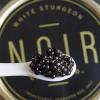Guidelines for Storing All Types of Caviar Safely
- Don't open it until it's needed.
- Refrigerate caviar, but don't freeze it as this can cause the roe membrane to toughen resulting in altered texture. You can store caviar in your fridge for up to 20 days if it's unopened, and once it's opened, you must consume it within 3 days. Pasteurized caviar can be stored on the shelf for about 6 months, as long as it's unopened.
- If you have any caviar leftovers, cover and refrigerate them as soon as possible and consume them within a couple of days. If there's caviar left in the tin, smooth the surface and press a piece of plastic wrap directly on the surface before returning it to the fridge. This ensures that your caviar has minimal contact with the air, thereby increasing its shelf life. Make sure that you turn the tin over every day for the oil to reach all the eggs.
How to Serve Caviar
When it comes to serving caviar, you have a few options. You can either serve it in its tin, in a glass server, or in a mother or pearl server - but always serve it on a bed of shaved ice.
Follow these guidelines to get the optimal caviar experience:
- Always be gentle when spooning out the caviar as the roe is extremely tender and fragile.
- Remove caviar jars from the fridge at least 10 minutes before serving, and only open them immediately before consumption.
- Two of the most popular beverages to serve with simple caviar are frozen vodka and dry champagne (or sparkling wine).
- Never cook caviar, as this will cause it to toughen. If a recipe calls for the use of caviar, only use it at the end or as a garnish.
- You should always serve caviar using a non-metal spoon. Metal spoons, including silver, impart a metallic flavor to the roe granules. There are various options available, including tortoiseshell, bone, glass, and the ever-popular mother of pearl spoon.
As you can see, the process of storing and serving caviar isn't complicated at all.
The only time you may encounter problems is when you have too much caviar and are unable to eat it all in one sitting. In such a case you would be forced to freeze it. If you find yourself facing such an emergency, then go ahead and freeze the caviar, but ensure that you do so at a temperature of between 28 and 32 degrees Fahrenheit.
The taste won't really be affected, but the texture will definitely change which diminishes the caviar experience for a lot of people. When you need to use the frozen caviar, thaw it slowly in your fridge prior to serving, and even then only serve it as a garnish.









